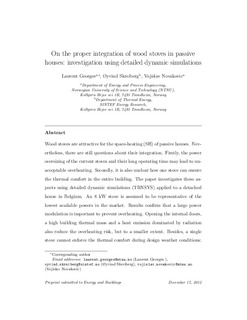| dc.contributor.author | Georges, Laurent | |
| dc.contributor.author | Skreiberg, Øyvind | |
| dc.contributor.author | Novakovic, Vojislav | |
| dc.date.accessioned | 2016-10-04T14:45:18Z | |
| dc.date.accessioned | 2016-10-10T08:24:39Z | |
| dc.date.available | 2016-10-04T14:45:18Z | |
| dc.date.available | 2016-10-10T08:24:39Z | |
| dc.date.issued | 2013 | |
| dc.identifier.citation | Energy and Buildings 2013, 59:203-213 | nb_NO |
| dc.identifier.issn | 0378-7788 | |
| dc.identifier.uri | http://hdl.handle.net/11250/2413787 | |
| dc.description.abstract | Wood stoves are attractive for the space-heating (SH) of passive houses. Nevertheless, there are still questions about their integration. Firstly, the power oversizing of the current stoves and their long operating time may lead to unacceptable overheating. Secondly, it is also unclear how one stove can ensure the thermal comfort in the entire building. The paper investigates these aspects using detailed dynamic simulations (TRNSYS) applied to a detached house in Belgium. An 8 kW stove is assumed to be representative of the lowest available powers in the market. Results confirm that a large power modulation is important to prevent overheating. Opening the internal doors, a high building thermal mass and a heat emission dominated by radiation also reduce the overheating risk, but to a smaller extent. Besides, a single stove cannot enforce the thermal comfort during design weather conditions: a peak-load system is then needed. Using more standard conditions, a Typical Meteorological Year (TMY), the stove can mainly perform the SH but it then requires the internal doors inside the building to be opened. The temperature distribution between rooms is in fact dominated by the architectonic properties. Finally, the emission and distribution efficiency of the stove is also investigated. | nb_NO |
| dc.language.iso | eng | nb_NO |
| dc.publisher | Elsevier | nb_NO |
| dc.title | On the proper integration of wood stoves in passive houses: investigation using detailed dynamic simulations | nb_NO |
| dc.type | Journal article | nb_NO |
| dc.type | Peer reviewed | nb_NO |
| dc.date.updated | 2016-10-04T14:45:18Z | |
| dc.source.volume | 59 | nb_NO |
| dc.source.journal | Energy and Buildings | nb_NO |
| dc.identifier.doi | 10.1016/j.enbuild.2012.12.034 | |
| dc.identifier.cristin | 980073 | |
| dc.relation.project | Norges forskningsråd: 193817 | nb_NO |
| dc.description.localcode | © 2013 Elsevier B.V. All rights reserved. This is yhe authors' accepted and refereed maniscript to the article. Locked until april 2015 due to copyright restrictions. Author's post-print must be released with a Creative Commons Attribution Non-Commercial No Derivatives License. | nb_NO |
